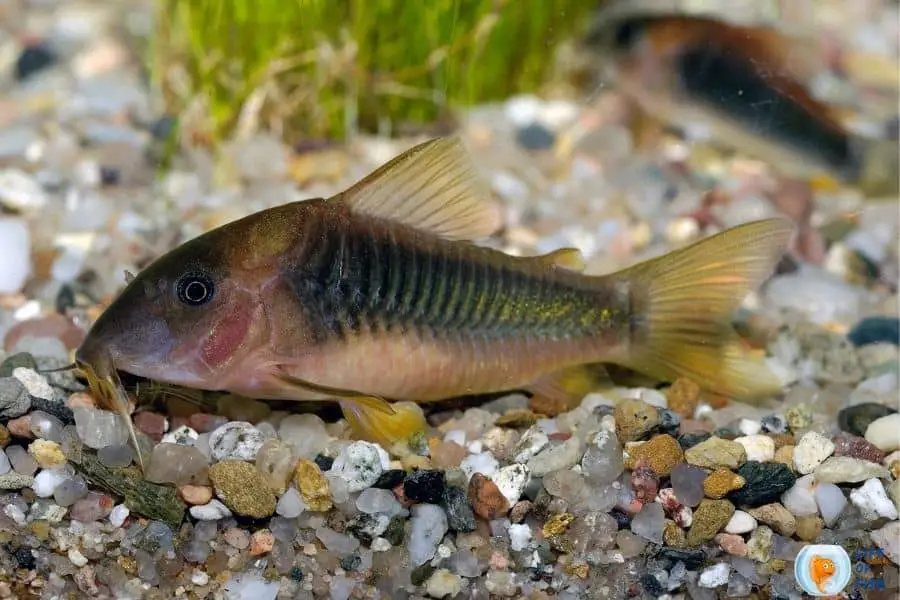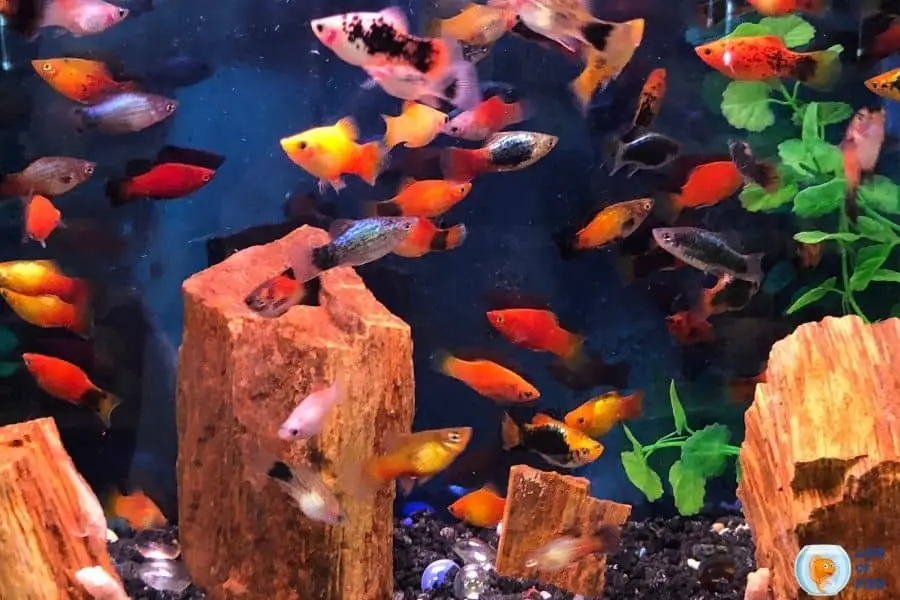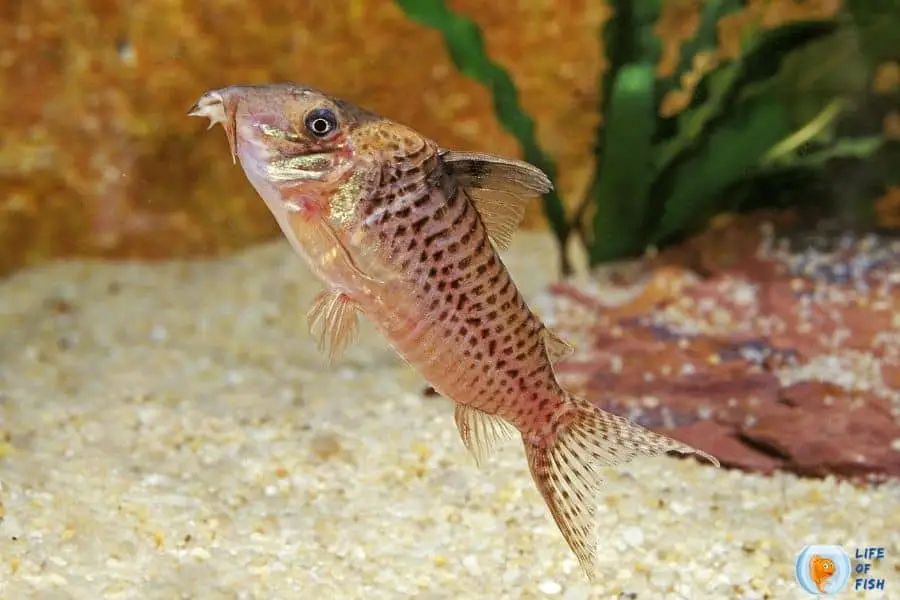Do corydoras eat baby platys? The short answer is no. Corydoras won’t eat your platy fry unless the fries are sick or dying.
Corydoras are opportunistic feeders and eat anything they can fit in their mouths, but they prefer food that falls onto the ground.

So, if you’re worried about your Corydoras eating your platy fry, you can rest assured knowing that it’s unlikely to happen.
Corydoras is a bottom-feeder fish that efficiently clean the tank by scavenging leftovers and uneaten food.
They are peaceful species that do well in a community tank. Because of their efficiency in cleaning the tank, many aquarists prefer to keep these fish in their aquariums. However, many have concerns regarding keeping these fish with baby platys.
But why your platy babies are safe to keep with Corydoras, and what more should you know?
We will get back to that, but first, let us take a look at what corydoras eat and some more basic facts about these fish.
About Corydoras
Jump To
- 1 About Corydoras
- 2 How big do corys get?
- 3 What do corydoras eat?
- 4 Do corydoras eat fish?
- 5 Do corydoras eat baby platys?
- 6 Will corydoras eat eggs?
- 7 What fish will eat baby platys?
- 8 Why should you keep Corydoras with baby platys?
- 9 Do corydoras eat baby corys?
- 10 What fish can you keep with Corydoras?
- 11 Can I keep just one Cory catfish?
- 12 Related question
- 13 Conclusion
Corydoras are a species of aquarium catfish that are native to South America. They are freshwater fish belonging to the Callichthyidae family.
These fish are commonly known as cory cats or corys. Corydoras come in a wide range of colors and patterns, with over 160 species to choose from.
Corydoras are peaceful fish that do well in a community tank. They are schooling fish and prefer to live in groups of 6 or more.
Corydoras are bottom-dwellers and spend most of their time close to the substrate. They are known for their barbells, which they use to search for food on the substrate.
Corydoras are a hardy species of fish that are easy to care for. They can live in various water conditions and tolerate changes in water parameters.
Corydoras are long-lived fish species with a lifespan of 10-15 years.
How big do corys get?
Corydoras are a small fish species with an average size of 2.5-3.5 inches. However, some species can grow up to 4-5 inches in length.
What do corydoras eat?
Corydoras are opportunistic feeders and eat anything they can fit in their mouths. Their diet consists of decaying food, small invertebrates, worms, insects, and crustaceans in the wild.
In the aquarium, Corydoras will accept a variety of foods such as pellets, flakes, live foods, and frozen foods.
Do corydoras eat fish?
Corydoras are harmless that won’t bother other fish in the tank.
They much prefer live foods such as worms, insects, and crustaceans. However, they are opportunistic feeders and will eat anything they can fit in their mouths.
This includes small fish and fish fry. But, corydoras won’t swim after fish fry and actively hunt them down.
Do corydoras eat baby platys?
Corydoras do not actively hunt for fish and fish fry, as we mentioned above.
Therefore, they won’t eat baby platys as baby platys usually dwell in the upper parts of the tank where Corydoras don’t spend much time.
However, if the baby platys are sick or dying, they will come to the bottom of the tank and stay there. While baby platys are at the bottom of the tank, Corydoras might see them as an easy meal and eat them.
More often than not, baby platys that Corydoras eat are sick or dying. Since Corydoras are opportunistic feeders, they will eat anything they can fit in their mouths.
So, if you see your Corydoras eating baby platys, it’s most likely because the baby platys are sick or dying.

Will corydoras eat eggs?
If the eggs are laid on the bottom of the tank, the Corydoras may eat them.
Corydoras are not known to eat fish eggs, but they might eat them if they are close to the tank bottom, where the Corydoras spend most of their time.
To prevent Corydoras from eating the eggs, you can either remove the eggs or move them to a separate tank.
What fish will eat baby platys?
Many different species of fish eat baby platys. These fish include:
- Bettas
- Guppies
- Mollies
- Barbs
- Danios
- Cichlids
- Sharks
- Pufferfish
- Piranhas
Even adult platies may eat their own babies, so removing the fry from the tank as soon as they are born is essential.
The best way to do it is to move them to a separate tank. You can also use a breeding trap, a small cage that can be placed in the tank.
The platy fry will be safe in the breeding trap until it is big enough to release into the main tank.
Why should you keep Corydoras with baby platys?
A fish tank full of fry means lots of waste as there will be so much poop and leftover food.
Corydoras are known for their scavenging abilities and will help clean up the tank. They will eat any leftover food that the fry doesn’t eat and any dead or dying fry.
In addition, their waste helps to fertilize the plants in the tank, which is beneficial for plant growth.
Corydoras are a helpful species of fish in a tank with baby platys as they help clean up the tank. This will ensure ideal water conditions for your baby platys to thrive. You will also have less time cleaning the tank as the Corydoras will do most of your work!
Since platy fries are also top and middle dwellers, the fries don’t get eaten. Thus you don’t need to worry about your platy fry’s safety when keeping them with Corydoras.
Do corydoras eat baby corys?
While it is true that Corydoras don’t eat platy fries, in the case of baby corys, the story is different.
Corydoras will actually eat baby corys if they are small enough to fit in their mouths. Like the adults, baby corys are also bottom dwellers who spend most of their time close to the substrate.
This makes them an easy target for Corydoras. As baby corys can not swim well as their adults, they often get eaten by Corydoras.
To prevent Corydoras from eating baby corys, you can either remove the babies from the tank or move the adult corys to a separate tank.
What fish can you keep with Corydoras?
Corydoras are bottom-dwelling scavenger fish that have a peaceful nature.
They are also small, making them an easy target for larger fish. For these reasons, it’s essential to choose the right tank mates for your Corydoras.
Corydoras will fit into any community tank as long as the tank mates are peaceful and friendly. They can also get along with any bottom feeder fish if they are similar in size and temperament.
It’s best to avoid keeping Corydoras with fish that are known to be aggressive or nippy. These fish include,
- Oscars
- Texas cichlids
- Jack Dempsey
- Crayfish
- Other cichlids
Corydoras can get along well with any peaceful community fish. These fish include,
- Guppies
- Mollies
- Platies
- Swordtails
- Tetras
- Barbs
- Danios
- Rasboras
- Goldfish
Corydoras can even live peacefully with other aquarium inhabitants like filter-feeding shrimp and snails, unlike many other bottom-dwelling catfishes. Some compatible shrimps include,
- Amano shrimp
- Red cherry shrimp
- Ghost shrimp
- Vampire shrimp
- Bamboo shrimp
Some compatible snails include,
- Ivory Snails
- Mystery Snails
- Pond Snails
- Malaysian Trumpet Snails
- Gold Inca Snails
- Nerite Snails
- Ramshorn Snails
- Rabbit Snails
- Japanese Trapdoor Snails
As you see, the choices of tankmates for Corydoras are endless. You can even keep them with other bottom-dwelling scavengers like plecos and otocinclus catfish.
Just be sure that the tank mates are non-aggressive and friendly so that your Corydoras can live peacefully in the tank.

Can I keep just one Cory catfish?
While keeping just one cory catfish is possible, it is not recommended.
Corydoras are social fish that live in groups in the wild. You should keep corys in groups of at least five fish in the aquarium.
This will allow them to feel more comfortable and secure in their environment. It will also allow them to display their natural social behaviors.
If you must keep just one cory catfish, be sure to provide it with hiding places and a lot of plants in the tank.
This will help the fish feel more secure in its environment. You should also avoid keeping other fish known to be aggressive or nippy.
The best tank mates for a single cory catfish are peaceful community fish that are similar in size. These fish include guppies, mollies, platies, swordtails, tetras, barbs, danios, and rasboras.
Related question
Do corydoras eat baby guppies?
No, corydoras do not eat baby guppies. Like baby platys, baby guppies are also upper-dwelling fish that rarely go to the tank’s bottom. This makes them an unappetizing target for Corydoras.
Do corydoras eat algae?
No, corydoras do not eat algae. Algae is not a part of their diet in the wild. Therefore, they won’t eat algae that grow on the substrate, walls, plants, and decorations.
Corydoras are scavengers that often feed on small insects, crustaceans, and worms. However, they may nibble on algae wafers occasionally if they are hungry.
Do mollies and cory catfish get along?
Yes, mollies and cory catfish get along very well. This is because they are both peaceful community fish with a similar temperament.
They can also live in the same tank without any problems. Just be sure to provide plenty of space, hiding places, and plants for the Corydoras to hide.
Can neon tetras live with cory catfish?
Neon tetras can live with cory catfish as long as the tank is big enough and there are plenty of hiding places and plants for the Corydoras to hide. Corydoras are peaceful community fish that do well with other peaceful fish.
How many corydoras are in a 20-gallon?
A 20-gallon tank can hold 5-10 corydoras. This is because Corydoras are social fish that need to be kept in groups. They should also have plenty of space to swim and hide.
Conclusion
Corydoras are peaceful community fish that can be kept with a wide variety of fish. They are bottom-dwelling scavengers that often feed on leftover food that falls into the aquarium bottom.
Baby platys are upper-dwelling fish that rarely go to the bottom of the tank. This makes them an unappetizing target for Corydoras.
Therefore, Corydoras will not eat baby platys. However, Corydoras may eat baby platys if they are sick or weak. Since sick platy fries usually go on to the bottom of the tank to die, they are an easy target for Corydoras.
Read Next : How To Stop Platy From Breeding | Here Is How !! |
